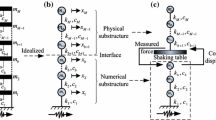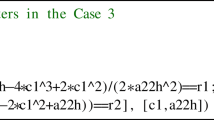Abstract
Finite element (FE) is a powerful tool and has been applied by investigators to real-time hybrid simulations (RTHSs). This study focuses on the computational efficiency, including the computational time and accuracy, of numerical integrations in solving FE numerical substructure in RTHSs. First, sparse matrix storage schemes are adopted to decrease the computational time of FE numerical substructure. In this way, the task execution time (TET) decreases such that the scale of the numerical substructure model increases. Subsequently, several commonly used explicit numerical integration algorithms, including the central difference method (CDM), the Newmark explicit method, the Chang method and the Gui-λ method, are comprehensively compared to evaluate their computational time in solving FE numerical substructure. CDM is better than the other explicit integration algorithms when the damping matrix is diagonal, while the Gui-λ (λ = 4) method is advantageous when the damping matrix is non-diagonal. Finally, the effect of time delay on the computational accuracy of RTHSs is investigated by simulating structure-foundation systems. Simulation results show that the influences of time delay on the displacement response become obvious with the mass ratio increasing, and delay compensation methods may reduce the relative error of the displacement peak value to less than 5% even under the large time-step and large time delay.
Similar content being viewed by others
References
Bonnet P, Williams M and Blakeborough A (2008), “Evaluation of Numerical Time-Integration Schemes for Real-time Hybrid Testing,” Earthquake Engineering & Structural Dynamics, 37(13): 1467–1490.
Chae Y, Kazemibidokhti K and Ricles JM (2013), “Adaptive Time Series Compensator for Delay Compensation of Servo-Hydraulic Actuator Systems for Real-time Hybrid Simulation,” Earthquake Engineering & Structural Dynamics, 42(11): 1697–1715.
Chang SY (2002), “Explicit Pseudodynamic Algorithm with Unconditional Stability,” Journal of Engineering Mechanics, 128(9): 935–947.
Chang SY (2009), “Explicit Pseudodynamic Algorithm with Improved Stability Properties,” Journal of Engineering Mechanics, 136(5): 599–612.
Chang SY, Yang YS and Hsu CW (2011), “A Family of Explicit Algorithms for General Pseudodynamic Testing,” Earthquake Engineering and Engineering Vibration, 10(1): 51–64.
Chen C and Ricles JM (2008), “Development of Direct Integration Algorithms for Structural Dynamics Using Discrete Control Theory,” Journal of Engineering Mechanics, 134(8): 676–683.
Chen C and Ricles JM (2012), “Large-Scale Real-Time Hybrid Simulation Involving Multiple Experimental Substructures and Adaptive Actuator Delay Compensation,” Earthquake Engineering & Structural Dynamics, 41(3): 549–569.
Gui Y, Wang JT, Jin F, Chen C and Zhou MX (2014), “Development of A Family of Explicit Algorithms for Structural Dynamics with Unconditional Stability,” Nonlinear Dynamics, 77(4): 1157–1170.
Maghareh A, Barnes MJ and Sun ZX (2012), “Evaluation of the 9-Story Benchmark Building Shear Model,” https://datacenterhub.org/resources/4503.
Mosalam KM and Günay S (2015), “Towards Faster Computations and Accurate Execution of Real-Time Hybrid Simulation,” Experimental Research in Earthquake Engineering, Springer, 65–81.
MATHWORKS (2014), MATHWORKS Company website. [Online]. Available: https://cn.mathworks.com/help/
Nakashima M, Kato H and Takaoka E (1992), “Development of Real-Time Pseudo Dynamic Testing,” Earthquake Engineering & Structural Dynamics, 21(1): 79–92.
Nakashima M and Masaoka N (1999), “Real-Time Online Test for MDOF Systems,” Earthquake Engineering & Structural Dynamics, 28(4): 393–420.
Ohtori Y, Christenson RE, Spencer BF and Dyke SJ (2004), “Benchmark Control Problems for Seismically Excited Nonlinear Buildings,” Journal of Engineering Mechanics, 130(4): 366–385.
Pissanetzky S (1984), Sparse Matrix Technology, Academic Press, Inc., London.
Rosen R (1968), Matrix Bandwidth Minimization, Mechanics Research, Inc., Los Angeles, California.
Saouma V, Kang DH and Haussmann G (2012), “A Computational Finite-Element Program for Hybrid Simulation,” Earthquake Engineering & Structural Dynamics, 41(3): 375–389.
Spencer BF, Christenson RE and Dyke SJ (1998), “Next Generation Benchmark Control Problem for Seismically Excited Buildings,” The Second World Conference on Structural Control, Kyoto, Japan, 1998.
Zhou MX, Wang JT, Jin F, Gui Y and Zhu F (2014), “Real-time Dynamic Hybrid Testing Coupling Finite Element and Shaking Table,” Journal of Earthquake Engineering, 18(4): 637–653.
Zhu F, Wang JT, Jin F, Zhou M and Gui Y (2014), “Simulation of Large-scale Numerical Substructure in Real-time Dynamic Hybrid Testing,” Earthquake Engineering and Engineering Vibration, 13(4): 599–609.
Zhu F, Wang JT, Jin F and Gui Y (2016), “Comparison of Explicit Integration Algorithms for Real-time Hybrid Simulation,” Bulletin of Earthquake Engineering, 14(1): 89–114.
Acknowledgment
The authors greatly appreciate the financial support provided by the National Natural Science Foundation of China under Grant Nos. 51639006 and 51725901.
Author information
Authors and Affiliations
Corresponding author
Additional information
Supported by: National Natural Science Foundation of China under Grant Nos. 51639006 and 51725901
Rights and permissions
About this article
Cite this article
Wang, J., Lu, L. & Zhu, F. Efficiency analysis of numerical integrations for finite element substructure in real-time hybrid simulation. Earthq. Eng. Eng. Vib. 17, 73–86 (2018). https://doi.org/10.1007/s11803-018-0426-0
Received:
Accepted:
Published:
Issue Date:
DOI: https://doi.org/10.1007/s11803-018-0426-0




